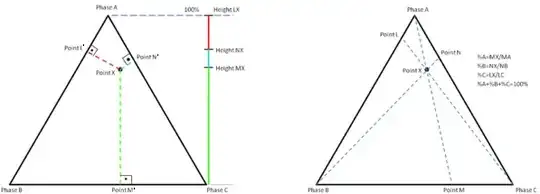I am trying to understand why ternary diagrams work. In order that the altitude criterion be valid, if I correctly understand, given equilateral triangle $ABC$, whose vertices I name as the three phases $A,B,C$, the sum $XL'+XM'+XN'$ (see figure on the left; I use the same notation for sides and their length) of the distances of point $X$, contained inside the triangle, from the sides must equate the height of $ABC$. Why does that holds?

Moreover, in order that the intersection method hold and the ratios between the three phases be respected, I would say that, if we respectively call $L,M$ and $N$ the intersection point between straight line $\overline{CX}$ and $AB$, between straight line $\overline{AX}$ and side $BC$ and between straight line $\overline{BX}$ and side $AC$, I would say that the following equality should hold:$$\frac{AN}{CN}=\frac{AL}{BL}\frac{BM}{CM}$$because, if $a,b$ and $c$ respectively are the quantities of phases $A,B$ and $C$, I would say that the equality is equivalent to $\frac{c}{a}=\frac{b}{a}\frac{c}{b}$ (where the factors correspond to each other: $\frac{c}{a}=\frac{AN}{CN}$ etc.). How can it be proved?
While ternary diagrams are ubiquitous in several sciences, like geology, I can find nothing explaining the mathematical foundations of such diagrams, why they work. I suspect that what I have said can be proved by using elementary or analytic geometry, but I must admit that I can find no way to prove them to myself (there is possibly some rust on my knowledge of elementary geometry). I thank you very much for any answer!
